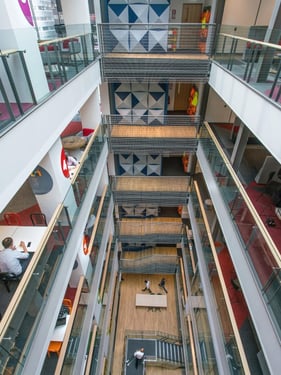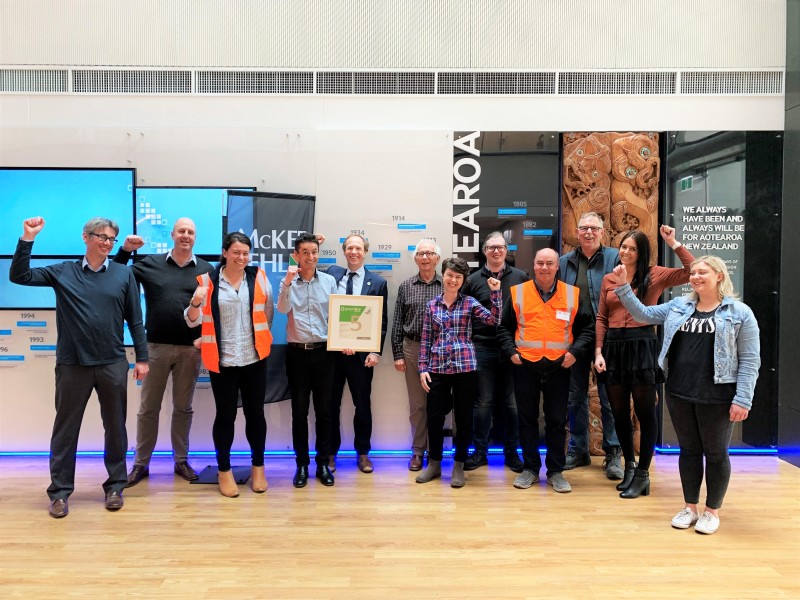Transformational refurbishment awarded 5 Green Star rating
Essentials

What: Waikoukou – a highly contemporary, energy-astute commercial building redeveloped from two disjointed tower blocks
Tenant: Transpower New Zealand Limited, state-owned enterprise, owner and operator of the National Grid
Where: 22 Boulcott Street, Wellington
Occupancy: 660 people
Project Snapshot
Owner: Cheops Holdings Limited
Architect: Architecture Plus Ltd
Service engineer: COR Associates, NME
Main contractor: McKee Fehl Constructors Ltd
GSAP: Jason Quinn, COR Associates
Project status: two year redevelopment, completed September 2017
Project Cost: $54 million
Project certification: 5 Green Star Office Built V3 (2020)
Integrating two dated and disjointed tower blocks into a cutting-edge entity in Wellington’s CBD was never going to be an ordinary project. And it was never going to deliver a humdrum result.
From the outset Cheops Holdings Limited’s ambitious plan to refurbish its building stock at 22 Boulcott Street was spearheaded by smart green thinking.
Alongside its sister company, McKee Fehl Constructors Ltd, Cheops is at the frontline of environmentally-responsible redevelopment in the capital.
Wrapping a Green Star rating around the Boulcott Street project dovetailed with its corporate and strategic goals.
“Cheops and McKee Fehl are very aware of the importance of smarter and greener construction in order to deliver better buildings and Green Star provides a framework to demonstrate this,” says Helen Moate, Project Manager, McKee Fehl Constructors Ltd.
“We are mindful of climate change and the response required by the building sector. Reducing our impact on the local environment in the areas of construction waste, operational energy and emissions, lines up with our commitment to improving the local industry.”

Situated a stone’s throw from the capital’s main shopping hub, the two office blocks at 22 Boulcott Street were originally part of a larger complex occupied by the iconic publisher Wellington Newspapers Ltd.
Known as the ‘north building’ (1930s) and ‘south building’ (1960s) they were dominated by dysfunctionality with differing floor levels, stairwells and dark interior spaces.
Now a highly innovative green refurbishment has transformed the tired towers into an exemplar of green-built excellence.
With a striking central six-storey light-filled atrium, the new-look building features connecting pedestrian bridges, a ‘floating’ central staircase and a high performance low-emission glazed curtain wall.
A full building services upgrade and major seismic strengthening has also been undertaken.
Project architect Kirsty Chamberlain of Architecture Plus Ltd says “positive project team relationships and careful, considered collaborative work” were the springboard for the project’s success.
“All parties were fully committed to designing a building which would provide the best possible environment for its future-users with minimal negative effects on the wider environment regarding construction processes, material selections and design of systems and spaces,” she says.

22 Boulcott Street’s high-flying 5 Green Star Office Built V3 rating salutes its portfolio of green features including very high performance glazing to maximise thermal performance and comfort, the refurbishment of the building’s core, high ventilation rates and high performance HVAC equipment.
Project GSAP and Senior Mechanical Engineer, COR Associates, Jason Quinn believes the standout feature is the renovation of an existing building and “retaining much of the concrete and steel core rather than demoing the entire site and building from the ground up.”
“Our lifecycle analysis shows this is not only a good economic strategy but also a good holistic minimization of carbon emissions strategy,” he says.
During the construction of 22 Boulcott Street 90 percent of building and demolition waste was diverted from landfill and over 3000 tonnes of concrete was recycled.
McKee Fehl says its project and site teams worked closely to integrate Green Star goals into day to day processes.
Waste was managed by a group of staff to ensure collection, sorting of materials and packaging integrated naturally into everyday housekeeping processes.
“We’re proud to have achieved 5 Stars which was a goal set very early in the project. Green Star helped attract our tenant Transpower New Zealand to the building and provided better assurance that a quality product would be delivered at the end of the day,” says Helen Moate.
The revamped building, named Waikoukou, has enabled Transpower to house all its staff under one roof.
Transpower says the spacious, well-lit, flexible spaces at Waikoukou have brought a sense of place and connectivity to its head office team.
“Much of what makes this building sustainable was predetermined in the design stage - from the materials selected to a design that allows for open spaces, the maximisation of natural light and the provision of a comfortable environment. All of which has increased our staff engagement and reduced operating costs,” says Richard McKeogh, Facilities Manager, Transpower New Zealand Ltd.

Green features include:
|
Technical features include:
|
